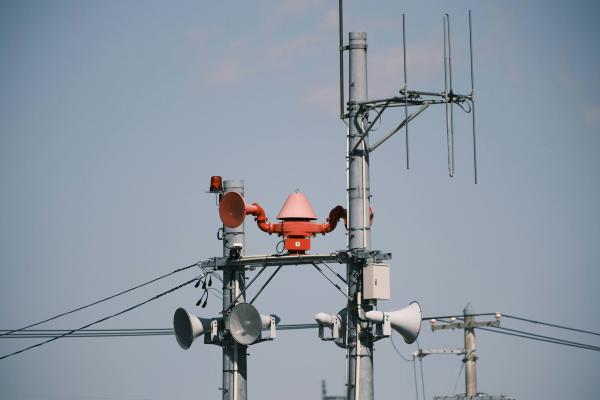By Dr Jamie Shea CMG, former Deputy Assistant Secretary General for Emerging Security Challenges at NATO
For resilience experts, even more than for its students and analysts, this past summer in the Global North has been a baffling and unsettling experience. Normally we can enjoy a pause between natural disasters and other catastrophic events to regroup and recover. Yet in 2023 barely a day has gone by without the TV headlines (and newsreel) reporting on yet another massive shock to the lives of our citizens, or to their homes, livelihoods and to the critical infrastructure on which they depend for their communications, transportation, food and energy supplies and business activities.
Within the space of a few weeks from June to August we have witnessed unprecedented wildfires in Canada where air pollution has extended as far down the eastern seaboard as New York and Washington, provoking respiratory distress and multiple lost working days. The whole city of Yellowknife in the Northwest Territories had to be evacuated and it took the Canadian firefighters a full three months (with considerable international assistance) to bring the fires under control. Meanwhile south of the border the United States has experienced record temperatures over 100 degrees Fahrenheit for weeks on end, once in a century floods in Southern California, where the local authorities usually prepare for drought, and festival goers at the Burning Man festival in Nevada (as well as the emergency services trying to rescue them) trapped in mud after unprecedented rainfall. Further south, traffic in the Panama Canal, a vital route for global container shipping and supply chains, was halved due to very low water levels in the canal.
Europe too was badly affected with the hottest summer on record in the Mediterranean. Aegean ferries were commandeered to serve as temporary hospitals for fire and heat victims evacuated from Alexandroupolis. The fires even ignited ammunition at a local Greek military base. British holidaymakers arrived in Rhodes one day and were sleeping on the floor of schools desperately seeking emergency flights home the next. Italy evacuated hundreds from Elba, and Spain thousands from Tenerife, while Portugal put 120 of its municipalities on a state of alert. Sea traffic in the Dardanelles was suspended when forest fires came dangerously close to the shore and firefighting planes had to take water out of the sea to douse forest fires on the Turkish-Greek border. And to demonstrate that climate change is not just an issue for southern Europe, Norway experienced its worst flooding in over a century.
Disasters like these are bad enough but they often hit countries that are already struggling to recover from previous catastrophic events, like last year’s earthquake in Turkey or hurricanes in Puerto Rico and the Caribbean.
All of this unusual weather is already threatening to overwhelm our emergency response services but other disruptions to our daily business occurred as well. We may have been thankfully spared a major terrorist attack, but hundreds of thousands of angry passengers were stranded abroad when the UK air traffic control system broke down at the end of August. The technical glitch may have been fixed within 24 hours but the knock-on effects percolated across airlines, hotels and tour operators for days afterwards, imposing considerable financial loss on those impacted. Meanwhile, law enforcement continues to work steadfastly behind the scenes to deal with the less visible threats to our well-being. A coordinated international police action in late August took down the Qakbot malware platform which so far this year has extracted $58 million in ransomware payments from companies and individuals. If this article had enough space we could discuss all the geo-political factors affecting global resilience such as the impact of the war in Ukraine on Black Sea grain shipments or the future of secure oil, gas and critical mineral supplies. We worried too after the sabotage of the Nord Stream 2 gas pipeline in the Baltic that vital underwater energy pipelines or cables powering over 90% of global communications could be at risk. Even a military coup in farther-away Niger raises immediate concerns regarding the supply of uranium for nuclear power stations.
Many disasters and systemic shocks are predictable and a fairly large number in the non-climate category are preventable. Yet in many cases the solutions are partial rather than total, and they will take many years to achieve, particularly in the area of limiting global warming and reducing carbon emissions. These solutions will also require a much higher degree of international cooperation and more far-reaching policy decisions (like the use of fossil fuels, for instance) than we seem ready for today. Immediate objectives like reducing inflation and keeping the lights on during a severe winter or international conflict can also hold up the longer term solutions such as managing the green transition. So resilience professionals cannot put their faith in long term solutions alone. Extreme conditions and simultaneous crises are not just particular to 2022 and 2023 but very much the new normal that we will see again next summer and for years to come. Simply waiting for the worst to happen and then responding with whatever we still have available is not an option. Making our societies, supply chains and critical infrastructure more resilient to the greater pressures being put on them is an urgent priority now. Good preparation globally will not avoid the shocks and the damage but it can lessen their impact, contain the human and financial loss, and help us to recover more quickly.
So what do resilience professionals in both government and the private sector need to discuss among themselves and with each other?
First, is to better map our vulnerabilities, like, for instance, those nodal points of a complex IT network that can spread disruption throughout the entire system or the connection points in a grid that are less well protected as one jurisdiction ends before another takes over. The UK air traffic control failure was made worse by the lack of a backup system. In any network, production line or supply chain there may be a single point of failure which then clogs up the entire production process, such as a particular electronic circuit board in a complex weapons system that holds up delivery of western weapons to Ukraine. In Germany earlier this year, damage to a single fibre optic cable disrupted train services for days in the north of the country. Dependence on a single supplier or trade route is always a risky business, and with multiple components made by multiple manufacturers, controlling global supply chains is virtually impossible. Yet frequently companies and individuals do not understand their vulnerabilities until something goes wrong and they have no Plan B ready to roll out. So understanding vulnerabilities is the starting point to accurately measuring risk.
Second, is to reduce those dependencies over time by diversifying supply chains and by building up reserve stocks as a cushion against supply cuts and disruptions. The EU now insists that its member states hold 90 days of gas supply in storage. Germany in a single year reduced its dependence on Russian gas from nearly 50% to 15%. Diversification can involve some difficult choices, such as the current debate in Germany whether to reopen decommissioned nuclear plants to avoid burning more coal and to supplement the greater use of wind and solar energy sources. Here public policy and assessing trade offs are as important as purely commercial policy and requires a high level of mature debate between the government and private sector as well as across borders. The decision of some EU countries to invest in new nuclear plants (Hungary and Croatia, for instance) has provoked controversy with their neighbours. After western countries have spent so much time and effort decoupling from fossil fuels supplied by authoritarian regimes (Russia, Iran, Venezuela), they must avoid creating new dependencies, for instance in hydrogen or lithium for electric vehicle batteries. China currently supplies over 90% of the rare earths used in industrial production, although the recent discoveries of abundant supplies of these minerals in northern Sweden and Greenland should help the west to improve its self-sufficiency.
Third, is to build networks and partnerships. The threats to our resilience often come in networked form as when several factors intersect to turn a problem into a major threat. Terrorism feeds on local grievances, poor governance, the impact of climate change on local communities and traditional lifestyles, organised crime giving easy access to guns and funding and social media boosting propaganda, communications and recruitment. This complicates the task for policymakers who need to deal with all of these issues at the same time. But it also means that striking back in one particular place may be more cost effective than trying to strike the entire spectrum all at once. Freezing the financial assets of terrorists or disrupting their communications may be more effective than risky commando operations to kill them in hostile environments. Identifying the key useful partners in dealing with the full spectrum of any given resilience challenge is key to successful crisis management. For instance, the Canadian government has forged an alliance with the European Space Agency (ESA) which has used imagery from its Copernicus-Sentinel ground observation satellite configuration to monitor the Canadian wildfires. It calculates the direction and speed of the fires from space, the temperatures in various segments of the fires and other elements such as the dryness of soils or the warming of the oceans that could create the conditions for future fires. Yet these critical partnerships cannot be surged in a crisis. They need to be built beforehand on the basis of trust and good human relationships.
Fourth, is to prepare for the worst case scenarios. The European Commissioner, Thierry Breton, has spoken of putting Europe “on an economic war footing”. Defence production lines have reopened to provide for rearmament funded by higher defence budgets. Ammunition, spare parts and logistics are being stockpiled at levels not seen since the end of the Cold War. Denmark even cancelled a public holiday to help pay for its military modernisation. Russia’s invasion of Ukraine has brought home to Europeans that war on their continent involving hundreds of thousands of dead and wounded, millions of displaced people and billions of euros of destroyed infrastructure and damaged buildings is no longer impossible. Russia has also, according to a US NGO, violated over 100 treaties and international conventions in carrying out its invasion. Dams have been blown up and large tracts of land flooded; grain silos and the water and energy grids have been deliberately targeted, adults and children forcibly deported to Russia, nuclear power plants occupied and their operations dangerously disrupted and schools, hospitals, theatres and train stations systematically targeted. War resilience may be an extreme form of worst case scenario, but civil emergency planning to ensure the continuity of government, food, water, energy and transport as well as coping with mass casualties is now being revived across Europe. Organisations like NATO and the EU are setting new standards for the protection of critical infrastructure, including the cybersecurity of IT and communication systems, and benchmarking the performance of member states. Regular tabletop and field exercises are testing the resilience of this infrastructure and its capacity to move military forces and equipment en masse across the Atlantic and the European mainland. During the Cold War most of the critical infrastructure, including ports, railways, shipping and telecommunications, was owned by the state. Today it is in the hands of the private sector and often foreign ownership or opaque beneficial ownership. So the risks of foreign direct investment need to be better assessed and ownership transparency is the first step here. Governments and the private sector need to share information and cooperate on resilience as never before. Exercises can help to identify gaps in response, improve working relationships and answer the question of “who do I call in a crisis?” Sometimes the response can come best from the local level, close to the domestic population; other times it comes best from the central government or the multinational level of the EU and NATO. These international bodies can share out resources among the member states according to need; good examples of this include French and Italian patients treated in German hospitals during the Covid-19 pandemic, or the way in which the EU is procuring a common fleet of water tanker aircraft to fight wildfires.
Finally, we need to be learning lessons from each other. According to the United Nations, only 11 countries out of 193 in the world are not being directly impacted by climate change. That small number will no doubt reduce further in the years ahead. Neutrality does not provide protection against terrorism, cyber attacks or supply chain disruptions resulting from other people’s conflicts. As we stumble from one crisis to the next, learning from each other’s experiences, successes and mistakes becomes ever more important. Inevitably some countries are better prepared or faster learners than others. Inevitably some have vastly more resources, and can protect themselves more easily and recover faster. The poorer countries of the world tend to leave everything to the central government or outside help. In richer countries well organised states, provinces and municipalities and a vibrant, socially responsible private sector can respond best and fastest. Situations and working cultures will always be different, but sharing lessons learned can prove invaluable in determining where to put resources; between preparedness and response, and between immediate aid to afflicted communities versus longer term investments in building better defences and more resilient communities.
Resilience professionals from across the globe need to come together and build a network of real time information sharing, early warning of impending threats, lessons from crisis management and public communication and longer term resilience improvements. Networking and information sharing are the means to develop foresight, which is the prerequisite for successful crisis management. Here we would be well advised to follow the advice of the great 18th century political philosopher and politician, Edmund Burke, who said that “the public interest requires doing today those things that men of intelligence and good will would wish, five or ten years hence, had been done.”
And this is precisely what Resilience First intends to do with its expert panel at the Risk and Resilience Conference which will take place at the International Security Expo at Olympia in London this coming 26 September. A tumultuous summer like the one we have just lived through provides illuminating insights into what we have learned to do well, and what we still need to learn to do better. Resilience First has already built this network of resilience professionals across the UK, involving government, academia and the full spectrum of the concerned private sector. Now it needs to take that knowledge and experience globally, engaging the UK’s important security partners along the way. Our panel - A New World Order: Are businesses shying away from globalisation? promises to be as stimulating and challenging as undoubtedly it will be informative and helpful. These are dramatic times that call for bold action but we are glad to have access to the expertise and sound policy judgement that Resilience First can uniquely provide. Please join us at the International Security Expo to continue the conversation.



